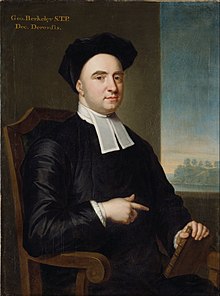George Berkeley | |
|---|---|
| Bishop of Cloyne | |
 Portrait of Berkeley by John Smybert, 1727 | |
| Church | Church of Ireland |
| Diocese | Cloyne |
| In office | 1734–1753 |
| Predecessor | Edward Synge |
| Successor | James Stopford |
| Orders | |
| Ordination | 1709 (deacon) 1710 (priest) |
| Consecration | 18 January 1734 |
| Personal details | |
| Born | 12 March 1685 |
| Died | 14 January 1753 (aged 67) Oxford, England |
| Denomination | Anglican |
| Spouse | Anne Forster |
| Children | 6 |
| Education | Philosophy career |
| Education | Trinity College, Dublin (B.A., 1704; M.A. 1707) |
| Era | 18th-century philosophy |
| Region | Western philosophy |
| School | Subjective idealism (phenomenalism) Empiricism Foundationalism[1] Conceptualism[2] Indirect realism[3] |
| Institutions | Trinity College Dublin[4] |
Main interests | Christianity, metaphysics, epistemology, language, mathematics, perception |
Notable ideas | Subjective idealism (esse est percipi), master argument, passive obedience |
| Signature | |
 | |
George Berkeley (/ˈbɑːrkli/ BARK-lee;[5][6] 12 March 1685 – 14 January 1753) – known as Bishop Berkeley (Bishop of Cloyne of the Anglican Church of Ireland) – was an Anglo-Irish philosopher whose primary achievement was the advancement of a theory he called "immaterialism" (later referred to as "subjective idealism" by others). This theory denies the existence of material substance and instead contends that familiar objects like tables and chairs are ideas perceived by the mind and, as a result, cannot exist without being perceived. Berkeley is also known for his critique of abstraction, an important premise in his argument for immaterialism.[7]
In 1709, Berkeley published his first major work, An Essay Towards a New Theory of Vision, in which he discussed the limitations of human vision and advanced the theory that the proper objects of sight are not material objects, but light and colour.[8] This foreshadowed his chief philosophical work, A Treatise Concerning the Principles of Human Knowledge, in 1710, which, after its poor reception, he rewrote in dialogue form and published under the title Three Dialogues Between Hylas and Philonous in 1713.[9] In this book, Berkeley's views were represented by Philonous (Greek: "lover of mind"), while Hylas ("hyle", Greek: "matter") embodies Berkeley's opponents, in particular John Locke.
Berkeley argued against Isaac Newton's doctrine of absolute space, time and motion in De Motu[10] (On Motion), published 1721. His arguments were a precursor to the views of Ernst Mach and Albert Einstein.[11][12] In 1732, he published Alciphron, a Christian apologetic against the free-thinkers, and in 1734, he published The Analyst, a critique of the foundations of calculus, which was influential in the development of mathematics.[13]
Interest in Berkeley's work increased after World War II because he tackled many of the issues of paramount interest to philosophy in the 20th century, such as the problems of perception, the difference between primary and secondary qualities, and the importance of language.[14]
- ^ Fumerton, Richard (21 February 2000). "Foundationalist Theories of Epistemic Justification". Stanford Encyclopedia of Philosophy. Retrieved 19 August 2018.
- ^ David Bostock, Philosophy of Mathematics: An Introduction, Wiley-Blackwell, 2009, p. 43: "All of Descartes, Locke, Berkeley, and Hume supposed that mathematics is a theory of our ideas, but none of them offered any argument for this conceptualist claim, and apparently took it to be uncontroversial."
- ^ The Problem of Perception (Stanford Encyclopedia of Philosophy): "Paraphrasing David Hume (1739 ...; see also Locke 1690, Berkeley 1710, Russell 1912): nothing is ever directly present to the mind in perception except perceptual appearances."
- ^ Cite error: The named reference
sepwas invoked but never defined (see the help page). - ^ Watson, Richard A. (1993–1994). "Berkeley Is Pronounced Barclay" (PDF). Berkeley Newsletter (13): 1–3. Archived from the original (PDF) on 3 July 2013. Retrieved 8 November 2010.
- ^ "Berkeley" entry in Collins English Dictionary.
- ^ Cite error: The named reference
Jessephwas invoked but never defined (see the help page). - ^ See Berkeley, George (1709). An Essay Towards a New Theory of Vision (2 ed.). Dublin: Jeremy Pepyat. ISBN 9781414283098.
- ^ Turbayne, C. M. (September 1959). "Berkeley's Two Concepts of Mind". Philosophy and Phenomenological Research. 20 (1): 85–92. doi:10.2307/2104957. JSTOR 2104957.
Repr. in Engle, Gale; Taylor, Gabriele (1968). Berkeley's Principles of Human Knowledge: Critical Studies. Belmont, CA: Wadsworth. pp. 24–33. In this collection of essays, Turbayne's work comprised two papers that had been published in Philosophy and Phenomenological Research:- "Berkeley's Two Concepts of Mind"
- C. Turbayne's reply to S. A. Grave, "A Note on Berkeley's Conception of the Mind" (Philosophy and Phenomenological Research, 1962, vol. 22, No. 4, JSTOR 2105263, doi:10.2307/2105263).
- ^ Berkeley's Philosophical Writings, New York: Collier, 1974, Library of Congress Catalog Card Number: 64-22680
- ^ Popper, K.R. (1 May 1953). "A note on Berkeley as precursor of Mach". The British Journal for the Philosophy of Science. IV (13): 26–36. doi:10.1093/bjps/IV.13.26. S2CID 123072861.
- ^ Also published: Conjectures and Refutations, Volume I, "A note on Berkeley as precursor of Mach and Einstein", Routledge and Kegan Paul, 1969.
- ^ jhollandtranslations.com
- ^ Turbayne, Colin, ed. (1982). Berkeley: critical and interpretive essays. Minneapolis, MN: University of Minnesota Press. ISBN 978-0-8166-1065-5.